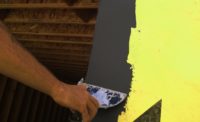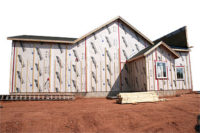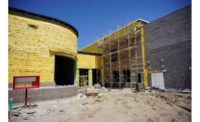Halo Exterra, a foam board insulation for above-grade exterior insulation applications is also designed to be a water-resistant barrier (which means that no building paper needs to be used).
How is this possible and what do installers have to say about it?
This blog post will show you exactly how Halo Exterra was constructed to be a water-resistant barrier and what builder Anthony Dew of Stalwood Homes thinks about it.
How Exterra is Constructed to be a Water-Resistant Barrier
There are two components that contribute to the water-resistant barrier capabilities of Exterra:
- its foam core thickness; and
- the use of laminates.
First and foremost, Exterra is made with a graphite polystyrene (GPS) foam core. GPS is a graphite-enhanced expanded polystyrene foam that provides superior R-value, and it’s this component that makes Exterra a unique foam board insulation product. For Exterra to act as a water-resistant barrier, its GPS foam core must be 9/16” or thicker.
Secondly, Exterra is also laminated on both sides with a polypropylene film (which adds durability and flexibility). The laminate layers of Exterra are precision-perforated, allowing air and moisture to escape and therefore resulting in another key benefit: its breathability. You can read more about the science here.
The key is to have breathable micro perforations and to still qualify as a water-resistant barrier, which is the unique balance that Halo Exterra achieves.
Exterra has also undergone rain penetration testing.




